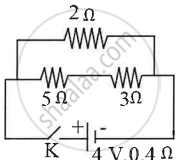Advertisements
Advertisements
प्रश्न
How does the resistance of a wire depend on its radius? Explain your answer.
उत्तर
Resistance of a wire is inversely proportional to the area of cross-section of the wire.
`R ∝ 1/"r"^2 or R prop 1/"a" or R ∝ 1/"𝜋𝑟"^2`
where 'a' is the area of cross-section and r is the radius of wire and R is the resistance. In other words thick wire offers less resistance and thin wire offers more resistance. In thick conductor electrons suffer less collisions.
APPEARS IN
संबंधित प्रश्न
How does the resistance of a wire depend on its length? Give a reason for your answer.
Name three factors on which resistance of a given wire depends and state how is it affected by the factors stated by you.
Draw a I–V graph for a linear resistor. What does its slope represent?
Assertion (A): Copper is used to make electric wires.
Reason (R): Copper has very low electrical resistance.
How are the home appliances connected in general, in series or parallel. Give reasons.
What is the maximum resistance one can make with ten 1Ω resistors?
______ is the only non-metal that is a good conductor of electricity.
Define the following:
Fixed resistor
Define the following:
Variable resistor
Observe the given circuit diagram and answer the questions that follow:

- Calculate the resistance of the circuit when the key K completes the circuit.
- Calculate the current through 3Ω resistance when the circuit is complete.
